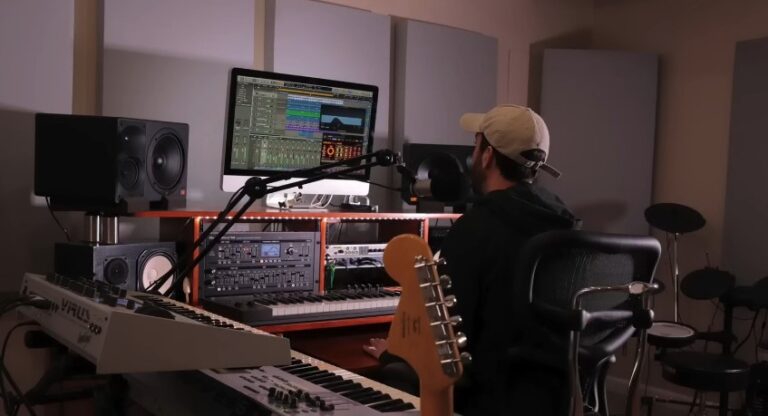Sweep picking is a guitar playing technique that involves ‘sweeping’ the pick across multiple strings in a single stroke. This technique allows guitarists to play arpeggios at high speeds with fluidity.
Mastering sweep picking requires practice, precision, and patience. In this article, we will explore ten effective exercises that can help guitarists improve their sweep picking skills.
Table of Contents
ToggleSweep Picking Basics
Before diving into specific exercises, it’s crucial to grasp the fundamentals of sweep picking. This technique is not just about speed; it requires control and synchronization between your picking hand and fretting hand. The goal is to achieve a smooth, flowing sound with each note distinctly heard. Starting slow is key, as it helps in building muscle memory and precision.
Exercise with Major Triads
Starting with major triads is an excellent way to familiarize yourself with the mechanics of sweep picking. A triad is a set of three notes, typically a root, third, and fifth, played in succession. Begin with a C major triad (C, E, G) and practice sweeping these notes across three strings. The focus should be on maintaining an even tempo and ensuring that each note rings out clearly without bleeding into the next.
Transitioning to Minor Triads
Once comfortable with major triads, shift to minor triads. This slight variation introduces a new shape for your fingers to adapt to, which is vital for dexterity and versatility. For instance, an A minor triad (A, C, E) involves a different finger positioning than a major triad. Practicing minor triads enhances your ability to switch between different chord shapes seamlessly.
Incorporating Seventh Chords
Seventh chords add complexity and richness to your sweep picking. These chords include four notes, adding another layer to your practice. For example, a C major seventh chord (C, E, G, B) requires sweeping across four strings. This exercise will challenge your precision and control, as you have to ensure clarity of each note.
Expanding Range with Extended Arpeggios
Extended arpeggios stretch across more strings, increasing the range and complexity of your sweep picking. For instance, practicing a C major arpeggio that spans from the fifth string to the first string. This exercise not only tests your sweeping technique but also your fretting hand’s ability to navigate across the fretboard efficiently.
Working on Speed and Fluidity
Once the basics are in place, focus on increasing your speed. However, speed should not come at the cost of clarity and precision. Use a metronome to gradually increase your playing speed while maintaining the integrity of each note. Fluidity in sweep picking is crucial, and this exercise aims to eliminate any jerkiness or unevenness in your playing.
Advanced Techniques: String Skipping
String skipping in sweep picking is an advanced technique that adds a new dimension to your playing. It involves skipping over strings while maintaining the sweeping motion. This technique requires a higher level of coordination and control. Practice with simple patterns at first, gradually increasing the complexity as you become more comfortable.
Integrating Sweep Picking into Solos
Applying sweep picking to musical contexts, such as solos, is where this technique truly shines. Try incorporating sweep-picked arpeggios into your guitar solos. This not only enhances your soloing repertoire but also helps in understanding how sweep picking fits within different musical styles and contexts.
Creating Your Own Sweep Picking Exercises
As you progress, start creating your own sweep picking exercises. This encourages creativity and helps in applying the technique to your personal playing style. Experiment with different chord progressions and patterns, and try to incorporate sweep picking into them.
Regular Practice and Patience
Like any skill, mastering sweep picking requires regular practice and patience. Consistency is key. Set aside dedicated practice time each day for these exercises. Remember, it’s about the quality of practice, not just quantity.
Balancing Dynamics in Sweep Picking
Dynamics play a significant role in making your sweep picking sound musical rather than just a technical display. Practicing with varying dynamics, such as playing softly then gradually increasing to a louder volume, adds expressiveness to your technique. This exercise helps in controlling the attack of each note, regardless of the speed at which you’re playing. It’s crucial to maintain clarity and evenness in tone throughout the dynamic range.
Mastering Muting Techniques
Muting unwanted string noise is essential in sweep picking. This requires a coordinated effort between both hands. While your picking hand sweeps across the strings, your fretting hand needs to mute the strings that are not being played. This exercise focuses on developing muting techniques to ensure that only the intended notes are heard. It’s a subtle skill but makes a significant difference in the cleanliness of your playing.
Combining Sweep Picking with Other Techniques
To truly integrate sweep picking into your playing style, combine it with other guitar techniques like hammer-ons, pull-offs, and slides. For instance, you can start a sweep-picked arpeggio and end it with a hammer-on or pull-off. This not only adds variety to your playing but also challenges your coordination and timing.
Practicing Inversions of Chords
Chord inversions offer a new approach to sweep picking. Instead of playing the root note of the chord at the bottom, start with the third or the fifth. This alters the shape and pattern of the arpeggio, providing a different sonic texture and a new set of challenges for your fingers. Practicing inversions broadens your understanding of chords and enhances your fretboard knowledge.
Exploring Different Musical Genres
Sweep picking is not just confined to rock or metal. Exploring its application in different genres like jazz, classical, or even pop can open up new avenues for creative expression. Try applying sweep picking techniques to different chord progressions and rhythms typical of these genres. This not only improves your versatility but also enriches your overall musicality.
Recording and Analyzing Your Playing
Recording your practice sessions can be incredibly beneficial. It allows you to listen back and critically analyze your sweep picking. Pay attention to areas where you might be struggling, like certain chord shapes or transitions between notes. This self-analysis helps in identifying and focusing on areas that need improvement.
FAQs
Can sweep picking be self-taught, or do I need a teacher?
Yes, sweep picking can be self-taught. Many resources are available online, including tutorials and exercise tabs. However, a teacher can provide personalized guidance, help correct mistakes, and offer structured learning. Whether you choose self-teaching or professional instruction, patience and consistent practice are key.
How long does it typically take to master sweep picking?
The time it takes to master sweep picking varies depending on individual practice habits, prior experience, and natural aptitude. For some, noticeable improvement might be seen in a few months, while for others, it could take years to achieve proficiency. Regular, focused practice is essential for progress.
Is sweep picking only suitable for electric guitar, or can it be done on acoustic?
Sweep picking can be performed on both electric and acoustic guitars. However, it is more commonly associated with electric guitar due to the genre of music it’s often used in and the lighter string gauge, which makes the technique easier to execute.
Are there any specific guitar setups or string gauges that are better for sweep picking?
A guitar setup with a lower action (distance between the strings and the fretboard) can make sweep picking easier, especially for beginners. Lighter gauge strings can also be more forgiving, allowing for quicker movement and less finger fatigue.
Can sweep picking lead to any bad habits or technique issues if not practiced correctly?
Yes, improperly practiced sweep picking can lead to bad habits, such as uneven timing, excessive string noise, and tension in the hands. It’s crucial to focus on precision, control, and relaxation during practice to avoid these issues.
What are some common mistakes to avoid when learning sweep picking?
Common mistakes include rushing the learning process, neglecting timing and rhythm, not muting unwanted string noise, and maintaining too much tension in the hands. It’s important to start slowly, focus on accuracy, and gradually increase speed while maintaining control.
Final Words
Sweep picking is a journey of continuous learning and refinement. The exercises discussed provide a structured approach to mastering this technique. However, the key lies in personalizing these exercises to fit your individual playing style and musical interests. Remember, the ultimate goal is to express yourself musically, and sweep picking is a powerful tool to add to your arsenal for this purpose. With dedication and regular practice, you can elevate your guitar playing to new heights and enjoy the creative freedom that comes with mastering sweep picking.
Related Posts:
- How Can You Strengthen Your Picking Skills Using…
- How to Tune a Guitar by Ear? Tips for Developing…
- Top Tips to Avoid Guitar String Buzz and Improve Tone
- How to Keep Your Strings from Breaking - Essential Tips
- How to Tune a Floyd Rose: Tips for Beginners and…
- Why Michael Jackson's "Thriller" Continues to Be the…









